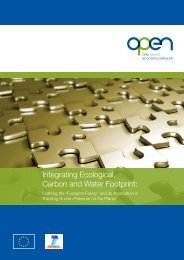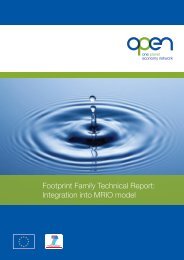OPEN: EU Scenario Storylines Report: - One Planet Economy Network
OPEN: EU Scenario Storylines Report: - One Planet Economy Network
OPEN: EU Scenario Storylines Report: - One Planet Economy Network
You also want an ePaper? Increase the reach of your titles
YUMPU automatically turns print PDFs into web optimized ePapers that Google loves.
The process was divided into three stages:<br />
1. Clarifying the purpose and structure of the scenario exercise<br />
Careful planning in the early stages of scenario development is essential to ensure the<br />
quality of any scenario exercise. This stage of work included clarification of why we are<br />
building the scenarios, the issues to be addressed (i.e. future development of<br />
consumption and production patterns in Europe) and defining the vision for the scenarios<br />
(i.e. a <strong>One</strong> <strong>Planet</strong> <strong>Economy</strong> in Europe by 2050).<br />
2. Laying the foundation for the scenarios – creating a scenario framework<br />
The future development of consumption and production patterns in Europe depends on<br />
the interaction of many different driving forces. Stakeholder input is essential at this<br />
stage to making sure the foundations of the scenarios take into account as many<br />
perspectives as possible. Expert stakeholders participating in the <strong>OPEN</strong>:<strong>EU</strong> scenario<br />
development workshop were asked to work in groups to identify potential trends and<br />
dynamics in drivers, as well as uncertainties associated with the trends and drivers that<br />
are especially important in determining how the future evolves, but whose future<br />
development is highly unpredictable. From an initially large number of driving forces,<br />
participants agreed on two that they considered as being the most ―critical uncertainties‖<br />
in determining how the future development of consumption and production in Europe<br />
evolves – these are:<br />
a) The momentum of technological innovation: ranging from dynamic to stagnant.<br />
For example, advances in electricity generation technologies could either be more or<br />
less rapid, with implications for the cost and availability of alternative options in the<br />
future and the ease of reducing the <strong>EU</strong>‘s carbon footprint to that of a <strong>One</strong> <strong>Planet</strong><br />
<strong>Economy</strong>.<br />
b) The motivating mindset behind the economic development paradigm: ranging<br />
from quality-of-life-driven to growth-driven. For example, the individual could see<br />
maximising income growth as more or less important compared with other nonfinancial<br />
forms of utility, with implications for the consumption of material goods and<br />
the ease of reducing the <strong>EU</strong>‘s impact across the Footprint Family.<br />
These two uncertainties were chosen by the participants as being the two driving forces<br />
behind the scenario framework. The <strong>OPEN</strong>:<strong>EU</strong> scenario framework plots the two<br />
uncertainties on two axes to create a matrix of four unique scenario quadrants,<br />
representing four sets of conditions within which consumption and production patterns in<br />
Europe could develop to 2050. This framework is presented in Figure 1 below.<br />
Page 13 of 57





